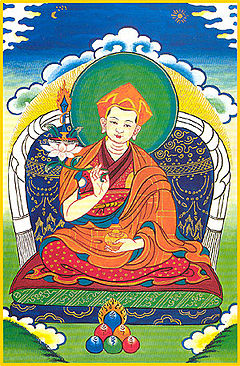
Dzogchen, also known as atiyoga, is a tradition of teachings in Indo-Tibetan Buddhism and Bon aimed at discovering and continuing in the ultimate ground of existence. The goal of Dzogchen is knowledge of this basis, this knowledge is called rigpa. There are spiritual practices taught in various Dzogchen systems for awakening rigpa.

Padmasambhava, also known as Guru Rinpoche and the Lotus from Oḍḍiyāna, was a tantric Buddhist Vajra master from medieval India who taught Vajrayana in Tibet. According to some early Tibetan sources like the Testament of Ba, he came to Tibet in the 8th century and helped construct Samye Monastery, the first Buddhist monastery in Tibet. However, little more is known about the actual historical figure other than his ties to Vajrayana and Indian Buddhism.
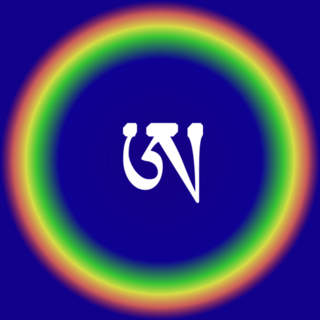
In Dzogchen, rigpa is knowledge of the ground. The opposite of rigpa is ma rigpa. A practitioner who has attained the state of rigpa and is able to rest there continuously is called a Rigdzin or Rigma, which may be used as a title either pre- or post-nominally.

Nyingma, often referred to as Ngangyur, is the oldest of the four major schools of Tibetan Buddhism. The Nyingma school is founded on the first lineages and translations of Buddhist scriptures from Sanskrit into Tibetan in the eighth century, during the reign of King Trisong Detsen.
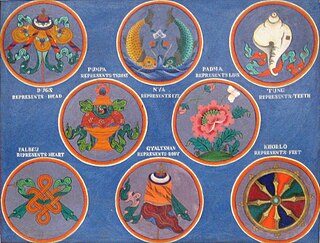
The Ashtamangala is a sacred suite of Eight Auspicious Signs featured in a number of Indian religions such as Hinduism, Jainism, and Buddhism. The symbols or "symbolic attributes" are yidam and teaching tools. Not only do these attributes point to qualities of enlightened mindstream, but they are the investiture that ornaments these enlightened "qualities". Many cultural enumerations and variations of the Ashtamangala are extant.
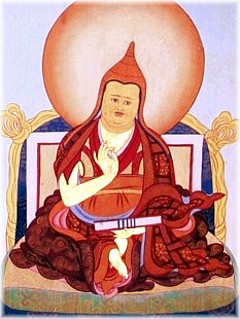
Jamgön Ju Mipham Gyatso, or Mipham Jamyang Namgyal Gyamtso (1846–1912) was a very influential philosopher and polymath of the Nyingma school of Tibetan Buddhism. He wrote over 32 volumes on topics such as painting, poetics, sculpture, alchemy, medicine, logic, philosophy and tantra. Mipham's works are still central to the scholastic curriculum in Nyingma monasteries today. Mipham is also considered to be one of the leading figures in the Rimé (non-sectarian) movement in Tibet.

Jigme Lingpa (1730–1798) was a Tibetan tertön of the Nyingma lineage of Tibetan Buddhism. He was the promulgator of the Longchen Nyingthig, the Heart Essence teachings of Longchenpa, from whom, according to tradition, he received a vision in which the teachings were revealed. The Longchen Nyingthik eventually became the most famous and widely practiced cycle of Dzogchen teachings.

Dzogchen Monastery is one of the "Six Mother Monasteries" of the Nyingma tradition of Tibetan Buddhism. It is located in Kham within modern day Dêgê County, Garzê Tibetan Autonomous Prefecture, Sichuan, China.
Semde (Tibetan: སེམས་སྡེ, Wylie: sems sde; Sanskrit: cittavarga, "mind division", "mind class" or "mind series" is the name of one of three scriptural and lineage divisions within the Dzogchen tradition. The Nyingma school of Tibetan Buddhism traditionally classifies its Dzogchen teaching into three main divisions: Semde, Longdé and Menngagde.
Longdé is the name of one of three scriptural divisions within Dzogchen, which is itself the pinnacle of the ninefold division of practice according to the Nyingma school of Tibetan Buddhism.
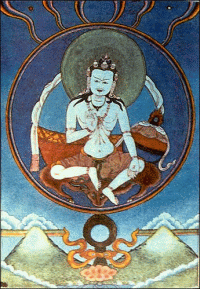
Garab Dorje was the first human to receive the complete direct transmission teachings of Sutra, Tantra and Dzogchen. The circumstances of his birth are shrouded in different interpretations, with some accounts describing a miraculous birth by a virgin daughter of the king of Uddiyana.
In Vajrayāna Buddhism, esoteric transmission is the transmission of certain teachings directly from teacher to student during an empowerment (abhiṣeka) in a ritual space containing the mandala of the deity. Many techniques are also commonly said to be secret, but some Vajrayana teachers have responded that secrecy itself is not important and only a side-effect of the reality that the techniques have no validity outside the teacher-student lineage.
In Dzogchen, rainbow body (Tibetan: འཇའ་ལུས་, Wylie: 'ja' lus, Jalü or Jalus) is a level of realization. This may or may not be accompanied by the 'rainbow body phenomenon'. The rainbow body phenomenon is pre-Buddhist in origin, and is a topic which has been treated fairly seriously in Tibet for centuries past and into the modern era. Other Vajrayana teachings also mention rainbow body phenomena which occur during or after the dying process.
The Five Pure Lights is an essential teaching in the Dzogchen tradition of Bon and Tibetan Buddhism. For the deluded, matter seems to appear. This is due to non-recognition of the five lights. Matter includes the mahābhūta or classical elements, namely: space, air, water, fire, earth. Knowledge (rigpa) is the absence of delusion regarding the display of the five lights. This level of realization is called rainbow body.

The Seventeen Tantras of the Esoteric Instruction Series or the Seventeen Tantras of the Ancients are an important collection of tantras in the Nyingma school of Tibetan Buddhism. They comprise the core scriptures of the "esoteric instruction series" (Menngagde) of Dzogchen teachings and are its most authoritative scriptures.

A charnel ground is an above-ground site for the putrefaction of bodies, generally human, where formerly living tissue is left to decompose uncovered. Although it may have demarcated locations within it functionally identified as burial grounds, cemeteries and crematoria, it is distinct from these as well as from crypts or burial vaults.
The Mirror of the Mind of Samantabhadra is one of the Seventeen tantras of Dzogchen Upadesha.
Pema is a Tibetan name meaning "lotus", which originated as a loanword from Sanskrit padma. People who have this name as one of their given names include:
In Tibetan Buddhism, Padma Gyalpo is one of the Guru Rinpoche's eight manifestations and appears in the form of a young prince. Pema Gyalpo means Lotus King. Padma Gyalpo is first of the Guru Rinpoche's Eight Manifestation, and is the form in which Guru Rinpoche took birth.

In Dzogchen, the view is one of the Three Dharmas of the Path of Dzogchen. The other two dharmas of the path are practice (gompa) and conduct (chöpa).
